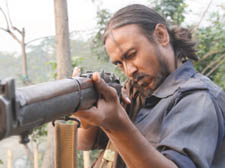|
|
 |
| |

Tanveer Hassan as Kala in The Last Thakur |
Film-makers achieve their aim of giving an insight into Bangladesh
THE LAST THAKUR
Directed by Sadiq Ahmed
Certificate 15
THIS exceptional Bengal language film has the air of a Western and is an Oedipus Rex tale set in modern day Bangladesh.
With stunning cinematography, a soundtrack which subtly creates an atmosphere – it is full of the chirrup of birds, the buzz of insects, the growl of stray dogs and the whine of radios – it transports you to Asia and wraps you up in a stunning story of political intrigue, family secrets and personal vengeance.
Thakur tells the story of an intense political rivalry between Thakur and the Chairman, laying bare the intrigues of a village riven by political divides. It also has an underlying message of how politics and religion are all too often used for personal gain. Featuring some of the best-known Bangladeshi actors working today, it is a stylish and beautifully produced film, carefully narrated through the eyes of Wasif, a young boy who earns a living serving in a tea hut.
And although shot entirely on location in rural Bangladesh, the film has Camden Town-based origins: producer Atif Ghani runs a film company based there, while director Sadiq Ahmed was a student at Kingsway College before studying at Central St Martins.
Atif was attracted to the story after Sadiq had asked his film company if they would sponsor him to go to the National Film School to learn the tricks of directing.
Atif turned him down. “He got a scholarship anyway,” explains Atif. “He then came back to us a year later and asked me if I’d lend him a camera to take to Bangladesh to make a film. I am afraid to say I said no, again.”
Sadiq was born in Bangladesh but grew up in London and was driven to return to the country to make a short film about Wasif, who he used again to narrate The Last Thakur.
“He came back from that trip with a 12-minute film,” recalls Atif. “I watched it and my first thought was: ‘let’s sign this kid up’.”
The short went to esteemed film festivals Sundance and Toronto and won rave reviews. It meant that when Sadiq asked for help to return to Bangladesh to make a feature-length film, Atif’s company, Aim Image, were only to happy to get onboard.
They travelled to Bangladesh and found a splendid location: the Thakur’s home in the film was a semi-derelict mansion of a Maharajah, which had around 400 people squatting in it as the filmed.
Some became extras, while the film crew were able to help. They installed toilets and bathrooms to be left behind in return for allowing them to film inside.
Another strength of this film are the incredible performances from the leading actors.
Above all, Atif hopes the film will bring to London a greater understanding of Bangladesh.
He said: “It has a population comparable to Brazil or Argentina and a large diaspora in Britain – but what most people know about Bangladesh is that they sometimes have floods.”
The film also draws on the theatrical life of Bangladesh. The country is riddled with theatre companies and is as popular there as going to the football is in Britain.
“We drew on this rich heritage as we made the film, and it is all the better for it,” said Atif.
This conclusion is one you cannot help agree with after viewing this original and intriguing story. |
 |
|
 |
| |
|
 |
|

